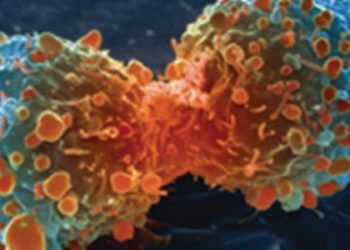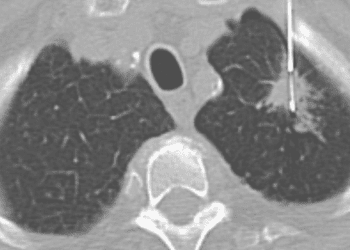Patritumab Deruxtecan in EGFR-mutated NSCLC post EGFR TKI and Chemotherapy
1. The objective response rate was 29.8% (1% complete response, 66% partial response) with a PFS of 5.5 months and a median OS of 11.9 months.
2. 64.9% of treatment-emergent adverse events (TEAEs) of grade ≥3, in which thrombocytopenia and neutropenia were the most common.
Evidence Rating Level: 2 (Good)
Study Rundown: Salvage therapy is limited for patients with EGFR-mutated advanced NSCLC who have failed the typical initial treatment with EGFR TKIs and second-line platinum-based chemotherapy. However, it was found that HER3, a protein linked to resistance to EGFR TKIs, is prevalent in NSCLC tumours, and a recent experimental therapy targeting HER3, Patritumab deruxtecan (HER3-DXd), showed initial promise in a phase I study. This is a phase II trial that evaluates HER3-DXd in EGFR-mutated NSCLC patients who previously failed EGFR TKI therapy and platinum-based chemotherapy. The primary endpoint was confirmed objective response rate (ORR) as either complete response or partial response. Secondary endpoints included duration of response (DoR), progression-free survival (PFS), overall survival (OS) and safety. The confirmed ORR was 29.8%, with 1% complete response and 66% partial response. The median duration of response was 6.4 months. The median PFS was 5.5 months and the median OS was 11.9 months. Outcome measures were similar in patients with and without central nervous system (CNS) metastases. Biomarkers were also analyzed and found that confirmed ORR ranged from 27.3% in patients with no identified EGFR TKI resistance associated genes, to 37.5% in patients with both EGFR dependent and independent resistance mechanisms. With regards to safety, there were 64.9% treatment-emergent adverse events (TEAEs) of grade ≥3, and 28.9% TEAEs of grade ≥4. The most common grade ≥3 TEAEs were thrombocytopenia (20.9%) and neutropenia (19.1%). TEAEs were associated with dose interruption in 40.4% of patients, dose reduction in 21.3%, and treatment discontinuation in 7.1%. The strengths of this study included a larger patient size compared to phase 1, and the limitations included a lack of a control arm. Overall, this study found some efficacy of HER3-DXd in patients with EGFR-mutated NSCLC who had previously failed EGFR TKI therapy and platinum-based chemotherapy.
Click to read the study in JCO
Relevant Reading: Efficacy and Safety of Patritumab Deruxtecan (HER3-DXd) in EGFR Inhibitor–Resistant, EGFR-Mutated Non–Small Cell Lung Cancer
In-Depth [prospective cohort]: This multicenter, open-label, phase II trial investigated previously treated patients with advanced EGFR-mutated NSCLC (exon 19 deletion or L858R), who received at least one EGFR TKI (mostly Osimertinib) and at least one platinum-based chemotherapy, into two dose schedules of HER3-DXd once every three weeks, a fixed-dose regimen (226 patients), and an uptitration regimen (51). The uptitrated regimen arm was closed after the risk/benefit was found to be similar to the phase 1 trial. These results are for the fixed-dose regimen. The median duration of follow-up was 19.8 months. It was found that ORR was 29.8% (95%CI, 23.9 to 36.2), with 1% complete response and 66% partial response. Median duration of response was 6.4 months (95%CI, 4.9 to 7.8). Median PFS was 5.5 months (95%CI, 5.1 to 5.9) and median OS was 11.9 months (95%CI, 11.2 to 13.1). The uptitrated arm had confirmed ORR 16.0% (95%CI, 7.2 to 29.1) and PFS was 6.7 months (95%CI, 4.2 to 8.8). Outcome measures were similar in patients with and without central nervous system (CNS) metastases, and a separate analysis of 30 patients with CNS metastases at baseline found the CNS ORR was 33.3% (95%CI, 17.3 to 52.8). Biomarkers were also analyzed from 193 patients with evaluable tumor tissue, and found that confirmed ORR ranged from 27.3% in patients with no identified EGFR TKI resistance–associated genes, to 37.5% in patients with both EGFR dependent and independent resistance mechanisms. With regards to safety, there were 64.9% treatment-emergent adverse events (TEAEs) of grade ≥3, and 28.9% TEAEs of grade ≥4. Most common grade ≥3 TEAEs were thrombocytopenia (20.9%) and neutropenia (19.1%) and median time to first onset was 8 and 21 days respectfully. TEAEs were associated with dose interruption in 40.4% of patients, dose reduction in 21.3%, and treatment discontinuation in 7.1%. Overall, this study found some efficacy of HER3-DXd in patients with EGFR-mutated NSCLC who had previously failed EGFR TKI therapy and platinum-based chemotherapy.
Image: PD
©2023 2 Minute Medicine, Inc. All rights reserved. No works may be reproduced without expressed written consent from 2 Minute Medicine, Inc. Inquire about licensing here. No article should be construed as medical advice and is not intended as such by the authors or by 2 Minute Medicine, Inc.

![Fluorophores enhance visualization for image-guided surgery [PreClinical]](https://www.2minutemedicine.com/wp-content/uploads/2015/01/FISH_13_21-350x250.jpg)





